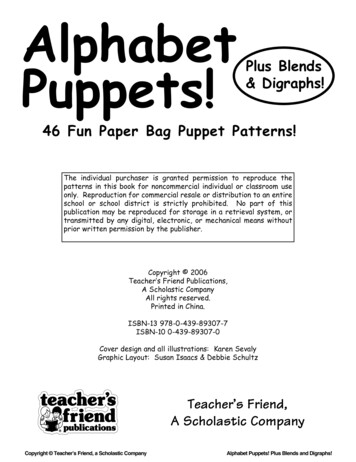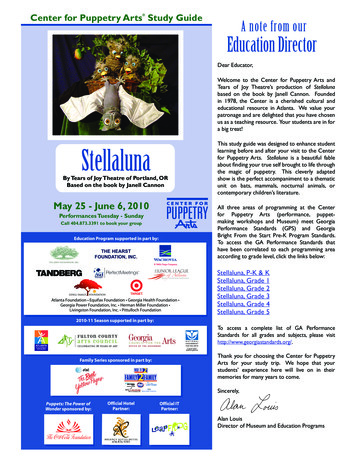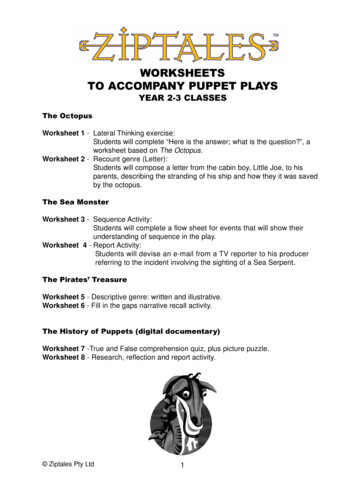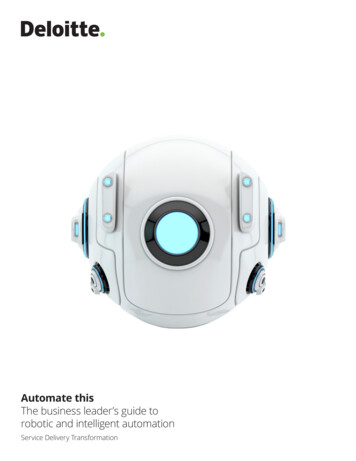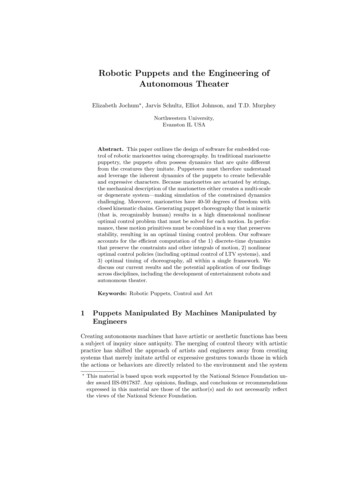
Transcription
Robotic Puppets and the Engineering ofAutonomous TheaterElizabeth Jochum? , Jarvis Schultz, Elliot Johnson, and T.D. MurpheyNorthwestern University,Evanston IL USAAbstract. This paper outlines the design of software for embedded control of robotic marionettes using choreography. In traditional marionettepuppetry, the puppets often possess dynamics that are quite differentfrom the creatures they imitate. Puppeteers must therefore understandand leverage the inherent dynamics of the puppets to create believableand expressive characters. Because marionettes are actuated by strings,the mechanical description of the marionettes either creates a multi-scaleor degenerate system—making simulation of the constrained dynamicschallenging. Moreover, marionettes have 40-50 degrees of freedom withclosed kinematic chains. Generating puppet choreography that is mimetic(that is, recognizably human) results in a high dimensional nonlinearoptimal control problem that must be solved for each motion. In performance, these motion primitives must be combined in a way that preservesstability, resulting in an optimal timing control problem. Our softwareaccounts for the efficient computation of the 1) discrete-time dynamicsthat preserve the constraints and other integrals of motion, 2) nonlinearoptimal control policies (including optimal control of LTV systems), and3) optimal timing of choreography, all within a single framework. Wediscuss our current results and the potential application of our findingsacross disciplines, including the development of entertainment robots andautonomous theater.Keywords: Robotic Puppets, Control and Art1Puppets Manipulated By Machines Manipulated byEngineersCreating autonomous machines that have artistic or aesthetic functions has beena subject of inquiry since antiquity. The merging of control theory with artisticpractice has shifted the approach of artists and engineers away from creatingsystems that merely imitate artful or expressive gestures towards those in whichthe actions or behaviors are directly related to the environment and the system?This material is based upon work supported by the National Science Foundation under award IIS-0917837. Any opinions, findings, and conclusions or recommendationsexpressed in this material are those of the author(s) and do not necessarily reflectthe views of the National Science Foundation.
2E. Jochum et al.dynamics. Ideally, this research will contribute to a deeper understanding of therelationship between art and the behavior of dynamical systems. However as theexperiments in this book demonstrate, it can be difficult to differentiate thosefeatures which distinguish artistic function from utilitarian function. Rather thanprecisely defining what makes a work of art artful —itself an elusive task thathas occupied art historians and aesthetic philosophers for centuries [1–3] —itcan be advantageous to use an established art form or practice as the basis forcriteria and evaluation of experiments. The aesthetic frameworks of establishedart forms such as dance [4], musical composition [5], or puppetry [6] provideexternal referents that enable researchers to measure the degree to which systemsare able to generate artistic behaviors or artifacts.Out project uses marionette puppetry as a testbed for exploring the automated synthesis of control strategies for complex, highly-dynamic, underactuated systems. Marionette puppetry has a unique approach to creating expressive,mimetic behaviors that approximate human gestures and behaviors using a rangeof abstracted motions that indicate —but do not replicate —recognizably human motions. In performance, puppets acquire a grace and agility not often seenin animatronics, themselves automated systems that aim at mimicry but whosemovements are typically heavy, slow, and perfunctory. The goal of our project isto emulate the control technique of human puppeteers and to develop automatedpuppets while maintaining the natural dynamics of marionettes. Controls strategies that preserve the marionette’s dynamics are important as puppets createthe illusion of life through the art of indication rather than precise mechanicalreproduction. We anticipate that our robotic marionette platform will allow fora wider, more artistic range of automated motions for entertainment robots.Artists and engineers have long experimented with developing efficient methods for simulating highly articulated rigid body systems [7–12]. However, theseefforts have typically focused on designing stable physical motions rather thanon control calculations. This paper focuses on the question of how to both simulate and control an arbitrarily complex rigid body system while maintainingscalability and convergence of the resulting numerical routines. Recognizing thepotential of this research for entertainment, industrial, and medical applications,we use a robotic marionette system (seen in Fig. 1) as an example of a complexsystem that requires carefully embedded control that can handle many degreesof freedom. String marionettes are interesting because they partly resist the puppeteers attempts to direct them: puppeteers are forced to compromise with thedynamics of the underactuated puppet to create recognizable representations ofhuman motion. A control-based analysis of string puppetry prompts the question of whether or not puppets can be programmed to perform autonomously—aquestion that has been considered with great vigor by theater artists [13–16] andis of increasing relevance given contemporary theatrical productions that combine animatronic technology with marionette control systems, such as GlobalCreatures’ How To Train Your Dragon (2012) and King Kong (2013).This project is a collaboration with Georgia Tech, the Atlanta Center forPuppetry Arts, and Walt Disney Imagineering/ Disney Research. Disney Imag-
Robot Puppets(a)3(b)Fig. 1: The robotic marionette system in (a) is actuated by small wheeled robotsthat run on the underside of a tarp. The goal is to use motion captured from thedancers in (b) as reference data for the marionettes. Software must transformthe dancers’ motion into dynamically admissible motion for the marionettes andcombine these motions together using choreography.ineering has played a central role in developing the hardware platform. Whilethe use of animatronics is widespread in film, museums, and theme-parks itsinfluence on live performance has been largely negligible. The absence of animatronics from theater stages can be attributed to the tremendous technicaldifficulties and safety risks posed by combining massive robots alongside humanperformers. However the more likely explanation for their absence is that animatronics lack the human-feeling and artistry found in the live performanceof direct-contact puppetry. When compared to marionettes, traditional animatronics are heavy, slow, and expensive. Robotic marionettes promise to be bothmore agile and less costly, and could potentially expand the possibilities for automated theatrical performances. For example Global Creatures 2013 productionof the stage musical King Kong combined traditional puppetry techniques withautomated marionette control to manipulate a six-meter tall silverback gorillaalongside human performers. While the partially-automated performance signaled a new paradigm for robotic puppets, the refined gestures and expressivebehaviors still relied heavily on real-time operation by human puppeteers [17]. Inthis case, the reliance on human puppeteers indicates the tremendous technical
4E. Jochum et al.challenges of automating a process that, through training, happens intuitivelyfor humans.Controlling marionettes is a very challenging technical problem: string marionettes have many degrees of freedom, have mechanical degeneracy due to thestrings, are very lowly damped, and are highly constrained. However, humanpuppeteers have demonstrated a reliable ability for controlling string marionettesand solving these high-dimensional motion planning problems—puppeteers convincingly imitate human motion using marionettes—so we know the problemsare solvable.Part of this project involved the authors working with professional puppeteersto formally understand how they prepare for performance and what decisionsthey make during performances. Working alongside puppeteers at the Centerfor Puppetry Arts in Atlanta, Disney Research, and the Denver Puppet Theater provided an opportunity to discover, in practical terms, how puppeteers seetheir jobs as a combination of algorithmic concerns (e.g., how does one organizemotion) and design concerns (e.g., how does one produce mechanical objectsthat are easily manipulated to produce desired motions). Puppets are complexmechanisms —controlling them involves constant trade-off between mechanicalcapacity and sophistication of expression. Puppeteers emphasize three phasesof motion imitation —Imitate, Simplify, Exaggerate —that represent the needto capture a motion, to then simplify it for reliable mechanical reproduction,and then exaggerate it for performance. Puppeteers also make strategic decisions about how to build a puppet that will be amenable to certain motions andhow to best coordinate the physical relationship between the puppeteer and theperforming object. Puppeteers coordinate the timing of a motion so they caninteract with other puppeteers, sometimes collaborating to control a single marionette or groups of puppets, ensuring that the marionettes remain animatedthroughout the performance. Scripts of puppet plays describe the action usingfour parameters: temporal duration, agent, space, and motion (i.e., when, who,where, and what). These motions are grouped and executed according to countsthat specify when each motion begins and ends. During rehearsals and performance, the puppeteer makes decisions about the use of force, dynamics, andmovement qualities that determine the expressive characteristics and the overallvisual effect, handling complex choreographic sequences and solving problems ofuncertainty, often before they arise. These are the processes that we set out tounderstand.Using a control-based analysis, we aim to understand how puppeteers manage complexity and uncertainty and apply these insights to autonomous theaterproductions and optimization problems in other critical areas. Our current hypothesis is that choreography plays a critical role in how puppeteers managecomplexity, and that the study of marionette choreography will further our understanding of other complex applications, such as embedded control of prosthetics (briefly discussed at the end of this article). Our goals are to synthesizemotion control for complex systems. To that end, choreography provides a way ofcategorically identifying useful and recognizable motions (e.g., walking, running,
Robot Puppets5waving, reaching) that can be combined together in phrases. How one combinesand orders these motions determines the stability and smoothness of transitionsbetween motions.This paper is organized as follows: Section 2 introduces marionette puppetryand articulates the distinct technical challenges of generating recognizable andartistic motions using marionettes. Section 3 describes typical analytical approaches in dynamic simulation and optimal control and the specific softwarerequirements these approaches create. Section 4 discusses which special considerations should be taken into account when working in discrete time. Section 5illustrates our software approach and briefly discusses examples of systems thatthe software automatically optimizes successfully. Section 6 discusses the relevant features of the current framework and the broader impacts for automatedpuppetry and the engineering of autonomous theater.2Puppets: Aesthetic and Mechanical ConsiderationsFrom antiquity to the present, artists and engineers have sought to create mechanical figures that generate expressive and lifelike behaviors [18, 13]. Puppetsare part of this lineage, and are representatives par excellence of humanity’s insatiable thirst for bringing ordinary object to life through motion. As art andtechnology scholar Chris Salter has observed, the histories of performing machines and robotic art have often involved a continual mingling between mimeticaspects (that is, objects that are imitative of lifelike behavior in appearance) andmachinic aspects (electromechanical behavior that, though animate, is not anthropomorphic) rather than a disambiguation [19]. That is, human artists areinterested in designing machines that emulate aspects of human creativity. Before the advent of computing and electronics, the approach was to design objectsthat appeared lifelike and imitated human actions, such as the 18th century humanoid automata built by Jacques de Vaucanson and Henri-Louis and PierreJaquet-Droz [20]. Puppets are the progenitors to these and other attempts tocreate mechanical life, and are part of a lineage that extends to present-dayanimatronics.Puppets can take the shape of realistic or abstract figures, and are designedfor use in theatrical settings. A puppet is generally defined as a material object that makes temporal use of sources of power that exist outside of itself,and that are not its own attributes [13, 21]. Animatronics are puppets that areelectronically controlled through various actuators (electrical, hydraulic, pneumatic), however the absence of a human performer and repetitive or open-loopperformance means that they are not typically regarded in the same way thathuman-powered puppets are. Setting aside for a moment the question of humanagency, we recognize that the main purpose of a puppet is movement: to establish a meaningful presence the puppet relies on motions to create a character orpresence that is both recognizable to the spectator and conveys a certain artistictruth. The puppet’s power of expression is therefore not determined by how wellit precisely mimics human behavior, but rather by its ability to abstract human
6E. Jochum et al.motions and offer an artistic projection of those motions and behaviors. In otherwords, the goal of puppetry motion is not to copy but to create. As Kingston etal. have also observed, a puppets primary purpose is to communicate throughmotion [6].Puppeteers are extremely inventive, and have developed numerous methodsfor controlling (often called “manipulating”) and constructing expressive, movingobjects. String marionettes are dynamically unique among puppets, and morethan other types of puppets have the potential to teach us about optimal control.Unlike glove puppets or rod puppets which are controlled through direct, corporeal contact (hands-on, hands-in), string marionettes are operated from above bya varying number of strings. For humanoid puppets, these strings are usually attached to the puppet’s head, torso, shoulders, arms, and legs, and can be strungto generate specific actions based on the specifications of the choreography. Thestrings can be manipulated with a variety of controls—the most common is themulti-stringed wooden control or “airplane” (crossbar) mechanism. This technique is used in Asian and European puppetry forms, and puppeteers can optto vary the string lengths and attachment points according to the needs of eachproduction or scene. The precision of the puppet’s motions is relative to thecontrol of the figures—the longer the strings, the weaker the impetus, which results in softer, less precise movements [13]. Puppeteers can control marionettesat ground level working alongside the puppet and in full view of the audience,or from a position high above the stage from a bridge and out of the audience’s sight lines. In either arrangement, the puppeteer must learn to balancethe dynamics of the puppet against the need to execute expressive choreographythat convincingly imitates—but does not replicate—human motions. Becausestring marionettes resist the puppeteer’s attempts to direct them, puppeteershave developed highly-evolved strategies for generating sequences of complexmotions—this is what is known as marionette choreography. Because of theirdynamics, string marionettes are arguably the most difficult type of puppet tooperate. This also makes them a good testbed for a control-based analysis.3Typical ApproachIn this section we discuss typical analytical approaches to optimal control andthe types of software infrastructure these approaches assume. We start with adiscussion of how one might describe the dynamics of a mechanical system andthen discuss computing optimal controllers for that system.3.1DynamicsMarionettes are subject to the physics of the world: they swing and sway according to the forces of gravity and the interplay between the different bodies—individual units such as the torso, forearms, and legs —in the marionette. Thisinterplay between the bodies falls within the realm of dynamics and simulation,where the dynamic description comes from a physics-based understanding of
Robot Puppets7puppet motion. When computing dynamics we are typically trying to computeequations of the formẋ f (x, u)(1)where x (q, q̇) and q Q describes the configuration of the system. For rigidbody systems, it has historically been convenient to write down the rigid bodysystem in Newton-Euler coordinates (i.e., Q SE(3)n , where n is the numberof rigid bodies in the system. This yields a state space of dimension 12n thatis subject to constraints. For a typical humanoid marionette, for instance, themarionette alone (no actuators) has 10 rigid bodies, so the state space wouldbe more than 120 dimensions. If one includes string actuation in the degreecount, that adds one degree of freedom for each string’s length and an additionalelement of SE(3) for each string endpoint (treating the inputs as “kinematicinputs” [22]). For a typical marionette with 6 strings of variable lengths, thisbrings the total nominal dimension of the state space up to 12 · 10 2 · 6 12 ·6 204. Naturally, we don’t want to be solving for feedback controllers in a204 dimensional space if it can be avoided. To avoid such high dimensions, we(a)(b)Fig. 2: Simulation of complex rigid bodies can take advantage of the mechanicaltopology of the system. For instance, a marionette is being simulated in (a) usinga tree structure representation of the humanoid form in (b) and representing theconstraints by cycles in the graph (see [23]).don’t want to represent Eq. (1) as Newton-Euler equations and instead insist onworking in generalized coordinates. In the case of the marionette, this reduces thedimension of the state to 2m, where m is the number of generalized coordinates.This yields 22 configuration variables for the marionette itself and another 18degrees of freedom for the string actuators (6 strings with endpoints moving inR2 R), yielding 80 states. By utilizing a kinematic reduction [24, 25] we canreduce the state of the actuators down to 18 because they are fully actuated.
8E. Jochum et al.This gives us equations of motion of the following form:ẋa uẋp f (xp , xa )(2)where xa is the kinematic configuration of the actuators and xp (qp , q̇p ) isthe dynamic configuration and velocity of the marionette itself. (For details onthis, see [22].) This leaves us with a much smaller, more manageable system towork with that only has a total of 62 dimensions in its state space. Crucially, thestrings are modeled as holonomic constraints, relating the lengths of the stringsto the dynamic configurations, of the formh(xa , qp ) 0(3)which must be maintained during simulation and control. Assuming for the moment that Eqs (2) and (3) can be stably simulated in an efficient manner, howdo we then construct the differential equation and constraints in a systematicmanner? The standard way to do this is based on Featherstone’s early work[12] on articulated body dynamics. This work was largely used in the contextof animation and digital puppetry, where the requirements are substantially different than embedded control. For example, animation requires a simulation to“look right” only once, while controlled physical systems must be repeatable.Recursive approaches to calculating dynamics [26, 12] take advantage of specialrepresentations of mechanical systems that allow the values needed for simulation to be calculated quickly and avoid redundant calculations. The work in thispaper is based on the methods presented in [23] (based on [12]). Here, systemsare represented as graphs where each node is a coordinate frame in the mechanical system and the nodes are connected by simple rigid body transformations(typically translations along and rotations about the X, Y , and Z axes, thoughany rigid body screw motion can be used). Transformations are either constantor parameterized by real-valued variables. The set of all variables establishes thegeneralized coordinates for the system. Figure 2 is an example of a simulatedmarionette. The graph description can include closed kinematic chains, but inpractice the graph is converted to an acyclic directed graph (i.e. a tree) and augmented with holonomic constraints to close the kinematic chains. This approachleads to fast calculations of f (·, ·) in Eq. (2) and h(·) in Eq. (3). Moreover, onecan use the same structure to efficiently calculate the linearization [27], which iscritical to nonlinear optimal control calculations, discussed in the next section.3.2Nonlinear Optimal ControlControlling marionettes involves choosing how the strings must be operated inorder to achieve some desired trajectory. For instance, if we wish a marionetteto generate a walking motion, the strings must pull the limbs in such a waythat the body of the marionette indicates walking. The choice of string motionswill, of course, depend on the physics-based description of the marionettes. For
Robot Puppets9instance, if the masses of the legs are very high, we might have to pull on thestrings differently than if the masses were very low. Optimal control plays asignificant role in determining the outcome because it provides an algorithmicmeans of choosing string lengths and endpoint positions in a manner that takesthe physics-based description of the marionettes into account. Optimal controltypically starts out with a cost function of some sort, often of the formZtfJ L(x(t), xref (t), u(t))dt m(x(tf ), xref (tf ))(4)t0where L(·) represents a weighted estimate of the error between the state and thereference state (which is potentially not a feasible trajectory for the system) suchas in the imitation problem mentioned above. We can minimize this cost functionsubject to the dynamics in Eqs. (2) and (3) by using iterative descent methods.In particular, one uses the equivalence between the constrained minimizationand the unconstrained minimization of the objective function composed with adifferentiable projection P(·) onto the constrained subspace. That is, the twominimizationsmin g(v) min g(P(v))v W Vv V(where V is the vector space and W is the differentiable submanifold of admissible vectors) are equivalent [28]. The projection operator P(·) comes fromcomputing a feedback law (discussed in more detail in the next section). In particular, if one interprets the “gradient” descent algorithm as starting at somenominal trajectory ξ (x(t), u(t)) and solving for a descent direction ζ (z, v)that optimizes the local quadratic modelζ arg min Dg(ξ) · DP(ξ) · ζ kζk2 ,ζthen one must only solve a standard time-varying LQR problem. This meansthat one must be able to compute the time-varying linearizationż A(t)z B(t)v(5) fwhere A(t) fdx (x(t), u(t)) D1 f (x(t), u(t)) and B(t) du (x(t), u(t)) D2 f (x(t), u(t)). One has to be able to do so for arbitrary trajectories in thestate space, potentially including infeasible trajectories (in the case of linearizingabout the desired trajectory). Solving for the descent direction involves computing the Riccati equationsṖ A(t)T P P A(t) Q P B(t)R 1 B(t)T P 0.(6)If we additionally want to guarantee quadratic convergence, then we can find adescent direction by solving a different LQR problemζ arg min Dg(ξ) · DP(ξ) · ζ kζk2D2 Jζ
10E. Jochum et al.whereD2 J(ξ) · (ζ 1 , ζ 2 ) D2 g(ξ) · (DP(ξ) · ζ 1 , DP(ξ) · ζ 2 ) Dg(ξ) · D2 P(ξ) · (ζ 1 , ζ 2 ).The second derivative D2 P(·) requires that we be able to also calculate22(7) 2fdx2 , fand dxdu. The details of this approach can be found in [28] and elsewhere,but for our purposes we should be able to compute Eqs. (2), (3), (4), (5), (6),and (7) in software. The difficulty of this approach is that we are representingthe optimal control problem in continuous time while the actual computationsare in discrete time. We will discuss this further in Section 4 and we see that itis only when we perform optimal control calculations in discrete time that wearrive at convergence of the algorithms that provide motion imitation. fdu2 ,3.3Choreography and Hybrid Optimal ControlIn [29–31] we developed an optimal control interpretation of puppet choreography. In particular, we formalized choreography as a sequence of modes that canbe pieced together to form a script of motions. Each mode has its own dynamics,creating a system with dynamicst (τi , τi 1 )ẋ f(x(t), u(t)) fi (x(t), u(t))where each i corresponds to a different mode of the system. To optimize such asystem, one needs to be able to minimize an objective function J with respect tothe switching times τi of the system. For a gradient descent algorithm, one must J—the derivative of the cost function withbe able to compute the derivative τirespect to the switching times—which depends on the switching time adjointequation L 0(8)ρ̇ A(t)T ρ xalong with a boundary condition at ρ(tf ) (see [32–35]). This adjoint equationonly needs to be computed once to compute all the derivatives of J. If one wantsto compute the second derivative of J, e.g. to utilize Newton’s method, then thesecond-order switching time adjoint equationṖ A(t)T P P A(t) 2L X 2f k ρk 0 x2 x2(9)kalong with its boundary condition P (tf ) must be solved [33]. This adjoint equation, along with a solution to Eq. (8), needs to be computed only once to obtain all the derivatives of J. Note that the second-order switching time adjointequation is the same as the Riccati equation in Eq. (6) except that the Riccatiequation has a different final term. Indeed, both Eq. (8) and Eq. (9) only requirefirst and second derivatives of fi with respect to the state, so those are all thatare needed for software; hence, the choreographic optimization requires the samesoftware capabilities as the smooth optimization described in Section 3.2.
Robot Puppets411Discrete time with scalabilityAs previously mentioned, the continuous representation of dynamics found inEq. (1) is not what we actually use to do computations. Moreover, when thereare constraints, such as those seen in Eqs. (2) and (3), standard methods suchas Runge-Kutta methods fail to preserve the constraints. Typically one woulduse solvers designed for Differential Algebraic Equations (DAEs) that projectthe numerical prediction onto the set of constrained solutions defined by theconstraint in Eq. (3). We have found, however, that for high-index DAEs suchas the marionette a tremendous amount of “artificial stabilization” is requiredto make the simulation of the DAE stable. This artificial stabilization—whichtypically takes the constraint h(q) as a reference and introduces a feedback lawthat “stabilizes” the constraint—changes the dynamics of the system, and if thefeedback gain is high, this often creates a multi-scale simulation problem thatis incompatible with real-time operation. As an alternative, we consider variational integrators [36–42]. Variational integration methods use the stationaryaction principle as a foundation for numerical integration that does not involvedifferential equations. This approach has several advantages such as guaranteesabout conservation of momenta, the Hamiltonian, and the constraints, as wellas guaranteed convergence to the correct trajectory as the time step convergesto zero. More importantly, variational integration techniques exactly simulate amodified Lagrangian system where the modified Lagrangian is a perturbation ofthe original Lagrangian. The Discrete Euler-Lagrange (DEL) equations areD1 Ld (qk , qk 1 , k) D2 Ld (qk 1 , qk , k) Fkh(qk 1 ) 0(10)(11)where Ld is a discretized form of the Lagrangian and Fk is an external forceintegrated over the k time step. This forms a root solving problem in which,given qk 1 and qk , one solves for qk 1 . Alternatively, one can utilize the discreteLegendre transform to define the discrete generalized momentum pk , and thenconvert the root solving problem of Eq. 11 into a one-step rootsolving problemwhere given the pair (qk , pk ) one implicitly solves for the next timestep pair(qk 1 , pk 1 ). Repeating this rootsolving procedure forms the basis of simulation.Using this method, we can (using a recursive tree description similar to the onedescribed in Section 3.1), simulate the marionette in real-time using time stepsof 0.01 s without adding any sort of numerical heuristics, such as artificial stabilization. Let’s say we start from the DEL equations and assume, by applicationof the implicit function theorem, that the solution exists and is locally unique[43]. Once we have made a choice of state (we choose xk (qk , pk )), we have anupdate equation of the formxk 1 fk (xk , uk )just as we would if we had started from a differential equation. That is, thegeneral form of the discrete time equation we wish to optimize is in principle nodifferent in the variational integrator case than it is in the standard ODE case.
12E. Jochum et al.Fig. 3: Software using variational integrators as the basis for simulation can accurately predict marionette motion using comparatively large time steps. In thiscase, the time step is dt 0.01s
Scripts of puppet plays describe the action using four parameters: temporal duration, agent, space, and motion (i.e., when, who, where, and what). These motions are grouped and executed a


